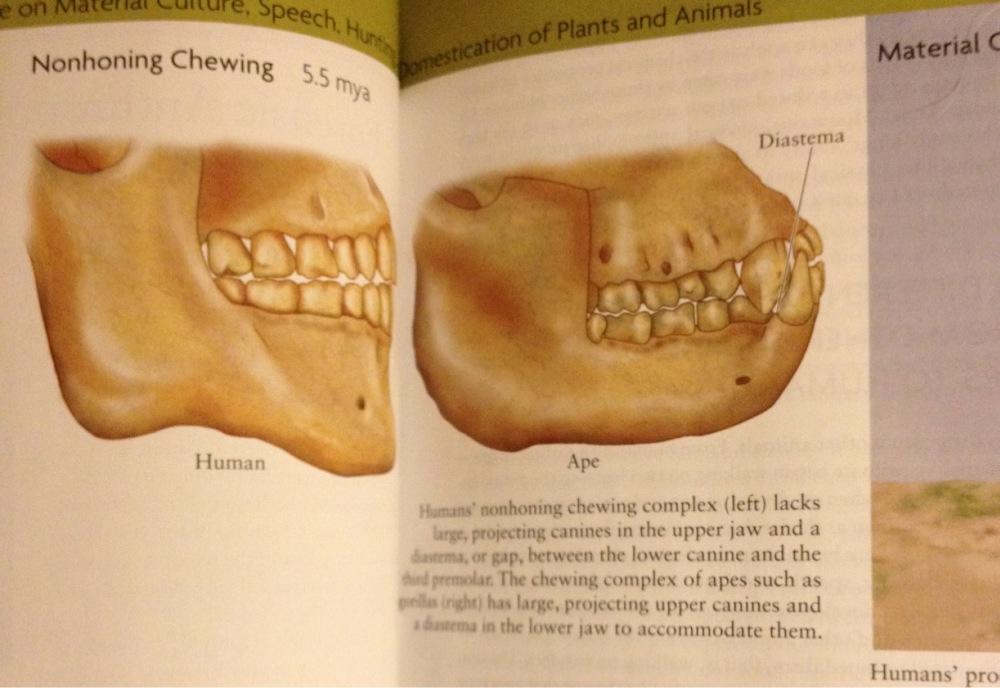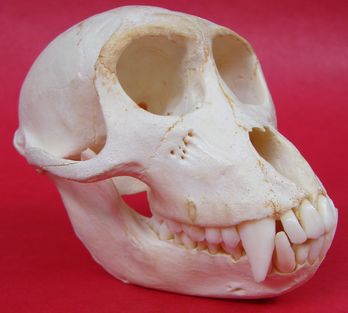A Honing Canine Is Used by Apes to
In addition to its masticatory function the upper canine may be very large especially among Old World monkeys and apes and used for social signaling and as a warning to potential predators. Determine the diet of a primate b.

Chapter 10 Flashcards Chegg Com
Cercopithecoids have narrow nose and palate and smaller brains relative to body sz Cercopithecoids molars are bilophodont but Hominoids have several cusps.

. It Examples of animals with. What is canine honing complex. A Honing Canine Is Used By Apes To.
What is archaeology anthropology. - Answers The dental form in which the upper canines are sharpened against the lower third premolars when the jaws are opened and closed. In apes transverse arch as seen in all primates and longitudinal arch unique to bipedal hominids very short toes not needed for grasping big toe boundadducted to other toes Another distinctive difference relates to the loss of the honing triad honing triad.
Differentiate between a hominin and an ape d. Canine-premolars honing complex The dental form in which the upper canines are sharpened against the lower third premolars when the jaws are opened and closed 16 Diastema Space between two teeth 17 Sectorial premolars Refers to. This sharpens the edges on the canine and premolar helping slicing up fruits and leaves.
Observations hypothesis predictions test. The loss of a large honing canine tooth like the one that apes typically use to shred their food to the simple nonhoning canine with which we simply process food. Domesticated foodsDefinition Place the steps of the scientific method in order.
Decrease of the maxillary canine projection has given more. The honing canine in both humans and our ancestors. What is canine honing complex.
Canine-premolar Honing Complex In Old World monkeys and some apes with the exception of humans canines are part of a canine-premolar honing complex in which the upper canine fits in a space or diastema between the lower canine and lower first premolar. Chapter 2- InQuizitive Quiz Thu Sep 15 215520 PDT 2016 A honing canine is used by apes to shred plant material What did Charles Darwin hypothesize about the origin of bipedalismTerm Name the six key attributes associated with humans. Y-5 molarapes have a characteristic pattern of cusps and fissures on one or more mandibular molars.
Differentiate between the sexes in a hominin species. A honing canine is used by apes to shred plant material What did Charles Darwin hypothesize about the origin of bipedalismTerm Name the six key attributes associated with humans. Changes in canine crown shape and reduction of the longest dimension within the hominine clade have eliminated the honing upper canine lower premolar P3 occlusal specialization of apes.
Our ancestors honing canine disappeared because they acquired the ability to make and use tools for processing food. The canine-premolar honing complex creates a continuously sharpened edge on each of the two teeth and is useful for slicing leaves. Why did our ancestors honing canine disappear.
Their upper canines are large pointed. The loss of a large honing canine tooth like the one that apes typically use to shred their food to the simple nonhoning canine with which we simply process food. They developed the ability to make and use tools for processing food.
This configuration slices food especially leaves and other plants. Objects that humans use to manipulate their environment tools. We do not use our premolars to sharpen the canines.
Cercopithecoids are laterally compressed with a narrower thorax and pelvis and a longer trunk. 1Bipedalism 2Non-Honing Caninie 3Material CultureTools 4Hunting 5Speech 6. Tools would have made it much easier to process tough leaves and hard nuts.
During human evolution some early human ancestors. Evidence for very early tool use coincides with the gradual loss of the honing canine. In species that have large canines which include most fossil and living apes this complex provides for the upper canines to be continually sharpened by wearing honing against the tooth immediately behind the lower canine.
When apes eat food the upper canines and lower premolars P3 rub against each other. The CP3 complex of our closest ancestors tells a series of events concerning human origins. Do Humans Have A Honing Canine.
Our ancestors honing canine disappeared because they acquired the ability to make and use tools for processing food. What is a honing canine. Because the main function of teeth is to chew foods a change in diet would have affected the size and shape of the teeth.
Archaeological anthropology is the study of past humans and cultures through material remains. Cercopithecoids have tails often long while Hominoids have no tails. A honing canine is used by apes to.
Y-5 molarapes have a characteristic pattern of cusps and fissures on one or more mandibular molars. Apes that have reduced their canine size like humans may lose the caninepremolar honing complex. The CP3 honing complex can be used to _____ asked Jul 4.
The Six Features that Make us Human. Apes have a honing chewing complex which is good for cutting and shredding food. Dog Breeds 6 minutes of reading.
Honing complex consisting of large canines that are sharpened honed on the first lower premolar termed a sectorial premolar. Determine the age of a primate fossil c. Different from the apes shredding canine we use this to process our food.
Honing complex consisting of large canines that are sharpened honed on the first lower premolar termed a sectorial premolar. Rather we use our premolars to help us grind foods. Six key attributes that make humans unique among primates.
What is a honing canine. Is a baboon an ape. Great Ape Characteristics.
Humans and apes will have much different wear on the teeth Apes will have sharper sides of teeth Human-Chimpanzee split Most of the early humans are found in eastern Africa.


No comments for "A Honing Canine Is Used by Apes to"
Post a Comment